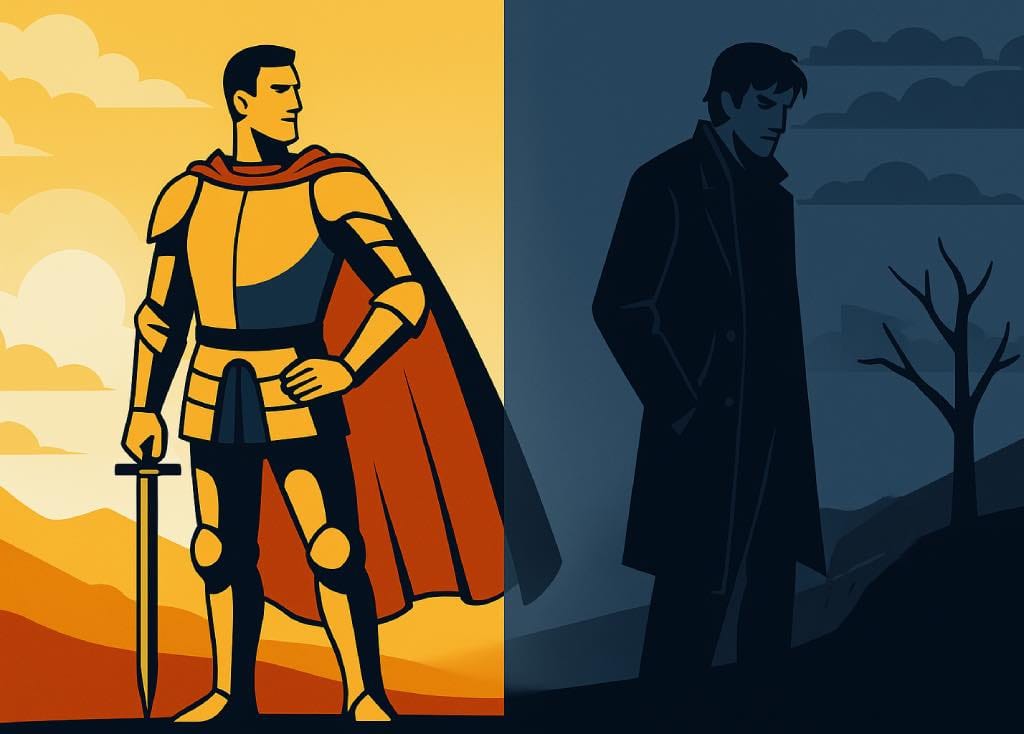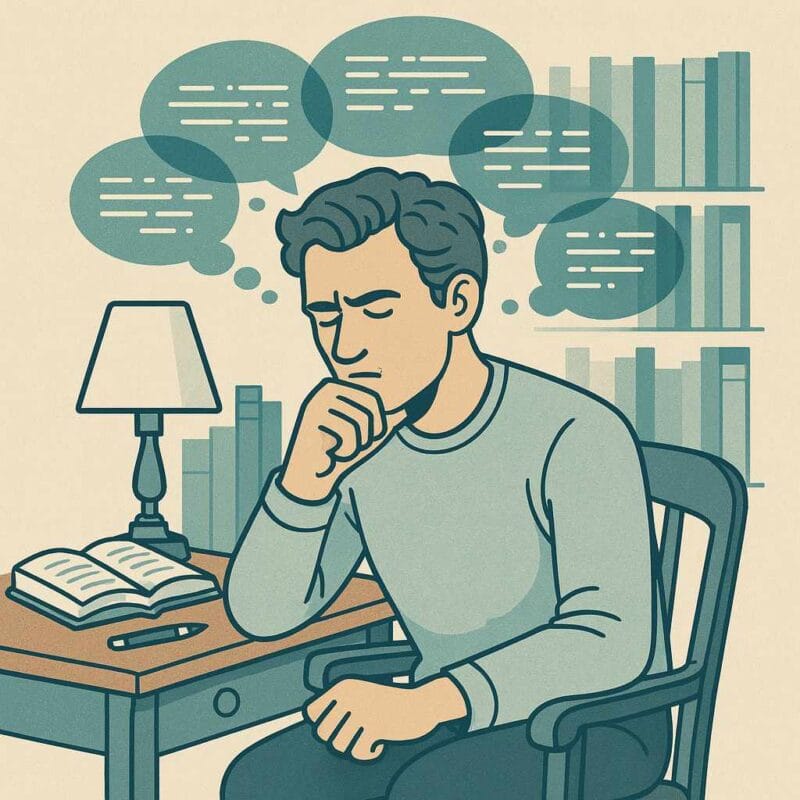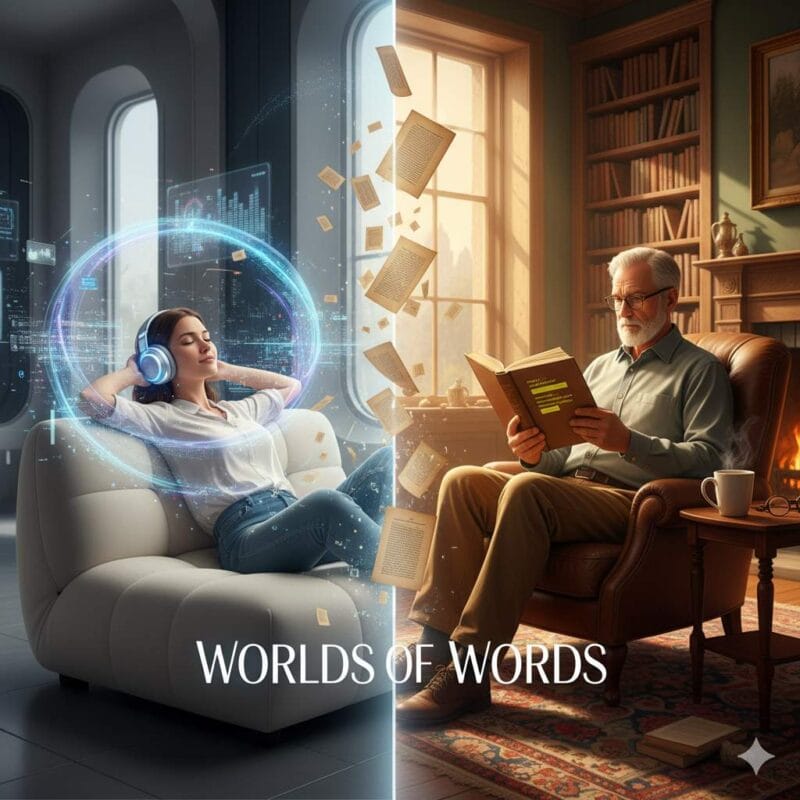In literature, the distinction between a hero and an antihero is often framed as a matter of moral alignment: one represents noble ideals, the other complicates or rejects them. But this contrast fails to address how these roles actually function within a story.
Heroes and antiheroes are not fixed types; they are shaped by narrative framing, context, and reader alignment. So, instead of asking what separates a hero from an antihero, a more revealing question might be: what causes a character to be perceived as either? The answer is rarely fixed.
The distinction depends not only on a character’s actions but on how a story frames those actions, and what the reader is led to excuse, admire, or condemn. Rather than setting them up as opposites, it is more revealing to examine how their actions are presented, what the story demands from them, and what expectations they inherit from the worlds they inhabit.
Why the Hero vs. Antihero Divide Falls Short
The binary between hero and antihero oversimplifies the roles they play. The supposed clarity between a virtuous protagonist and a morally compromised one breaks down when we account for how often both traits coexist in the same character.
Traditional definitions reduce heroes to noble actors and antiheroes to flawed rebels. But literature, as in life, rarely supports such rigid sorting. Think of Achilles, Hamlet, or Raskolnikov. Do they fit cleanly on either side? Not quite. They reveal how character morality often operates along a spectrum, shaped by power, motive, and context.
Characters on a Continuum
In many modern stories, this blurring is not a narrative flaw but a structural choice. The so-called “hero” may be unreliable, emotionally opaque, or ethically suspect. The antihero may display steadiness, courage, or sacrifice in ways the traditional hero fails to match. What matters most is not a character’s traits in isolation, but how the story organizes its moral weight to their choices.
Most fictional characters who attract sustained attention do not represent fixed positions on a moral chart. Instead, they move across a continuum of choice and consequence. In this sense, the distinction between hero and antihero becomes less about personality traits and more about how a story organizes its moral center. What counts as justice, loyalty, or failure depends on the values upheld within the story itself—and those values are often unstable.
Flaws, Power, and Consequences
What distinguishes a compelling character from a forgettable one often lies not in the presence of flaws but in their consequences. A deeply flawed character with no power might be a source of humor, pity, or tragedy—but not tension. Give that same character influence, and their flaws begin to shape the direction of the story. They become active forces that alter relationships, escalate conflict, and steer outcomes.
This is why antiheroes often dominate morally volatile settings. Captain Ahab in Herman Melville’s Moby-Dick (1851), Kurtz in Joseph Conrad’s Heart of Darkness (1899), and Tom Ripley in Patricia Highsmith’s The Talented Mr. Ripley (1955) are not simply flawed. What sets them apart is how their desires and rationalizations, unchecked by conscience or resistance, take root in positions of authority or persuasion. Their flaws are not just personality traits but mechanisms through which the story tests its limits.
Flaws alone, therefore, don’t define the antihero; it’s the combination of flaw and leverage. The more power a character holds, the more pressure their flaws exert on the story. The pressure they place on the world around them creates momentum, not because they act immorally, but because those actions shift the ethical boundaries the story is built on.
The Antihero is Not Simply the Villain
An antihero is not simply a villain in disguise. While both may act out of self-interest or operate outside traditional morality, the antihero remains central to the story’s emotional and ethical structure. They are often agents of conflict, not just sources of it. A villain opposes the protagonist; an antihero often is the protagonist—reluctant, compromised, or resistant to ideals, yet still carrying the weight of the story’s direction. Their flaws are not just obstacles; they are the very ground on which the story unfolds.
Reader Allegiance and Narrative Framing
A character’s label often depends on how closely the story aligns us with their internal world. When we are placed inside their thoughts—such as in Fyodor Dostoevsky’s Crime and Punishment (1866) or Vladimir Nabokov’s Lolita (1955)—we begin to tolerate, even rationalize, choices we might otherwise condemn. This kind of narrative proximity doesn’t require the character to be just or admirable. It simply makes their perspective difficult to dismiss.
The power of narrative framing lies in its ability to control what information is shared, and how. In George R. R. Martin’s A Game of Thrones (1996), for example, the rotating point of view causes shifting loyalties. Characters who initially seem heroic may reveal flaws or compromised motives over time. Others, initially cast as villains, earn complexity. The story resists a fixed hierarchy of virtue, instead emphasizing how allegiance depends on access to thought and motive.
When the Story Refuses a Clean Moral Map
There are stories in which the moral architecture itself has collapsed. In these stories, the antihero becomes a tool of realism, not rebellion. Winston Smith in George Orwell’s 1984 (1949) and Offred in Margaret Atwood’s The Handmaid’s Tale (1985) act not because they are brave in a conventional sense, but because doing nothing becomes intolerable. They don’t reject morality; they reject a system that rewards obedience and punishes dignity.
In these settings, idealistic heroes either don’t exist or are rendered ineffective. The antihero’s decisions carry more weight not because they are admirable, but because they are the only ones available within the constraints of their world.
Fiction Without Heroes
There are also works in which no character behaves heroically by any traditional measure. William Golding’s Lord of the Flies (1954) and Cormac McCarthy’s Blood Meridian (1985) offer bleak examinations of violence and instinct. The absence of a guiding moral presence leaves the reader without an anchor. These are not stories of redemption or clarity; they are stories about what happens when the mechanisms that support either fall apart.
Reframing the Question: Who holds the moral weight in a story?
The real difference between heroes and antiheroes lies not in their personal traits, but in how a story chooses to organize meaning around them. Heroes carry the weight of consequence; antiheroes test the limits of consequence itself. In many cases, the same character can be both—depending on what the story demands, and what it chooses to reveal.
In stories with morally ambiguous premise, the hero might be the character who absorbs the consequences of action. Meanwhile, an antihero might shirk that weight—until they can’t. In this case, the tension isn’t just between good and evil, but between agency and accountability.
Rather than seeing heroes and antiheroes as opposites, we might think of them as different answers to the same question: what kind of person does this world make possible? The most revealing stories aren’t those that present tidy moral contrasts but those that force us to wonder what makes one character bear the title of “hero” while another is cast as something else entirely.
Rather than treating these roles as opposites, it’s more productive to view them as positions on a shifting scale. What matters most is not who fits which label, but what those labels reveal about the world they inhabit—and the one we’re reading from.
Further Reading
The 10 Greatest Heroes of Greek Mythology by N.S. Gill, ThoughtCo
On Writing & The Brain: Is the Antihero Our Hero? by Cullen Traynor, The Writing Cooperative
Why antiheroes are a more realistic version of the heroes we wish we were by Jonathan Heaf, GQ Magazine




